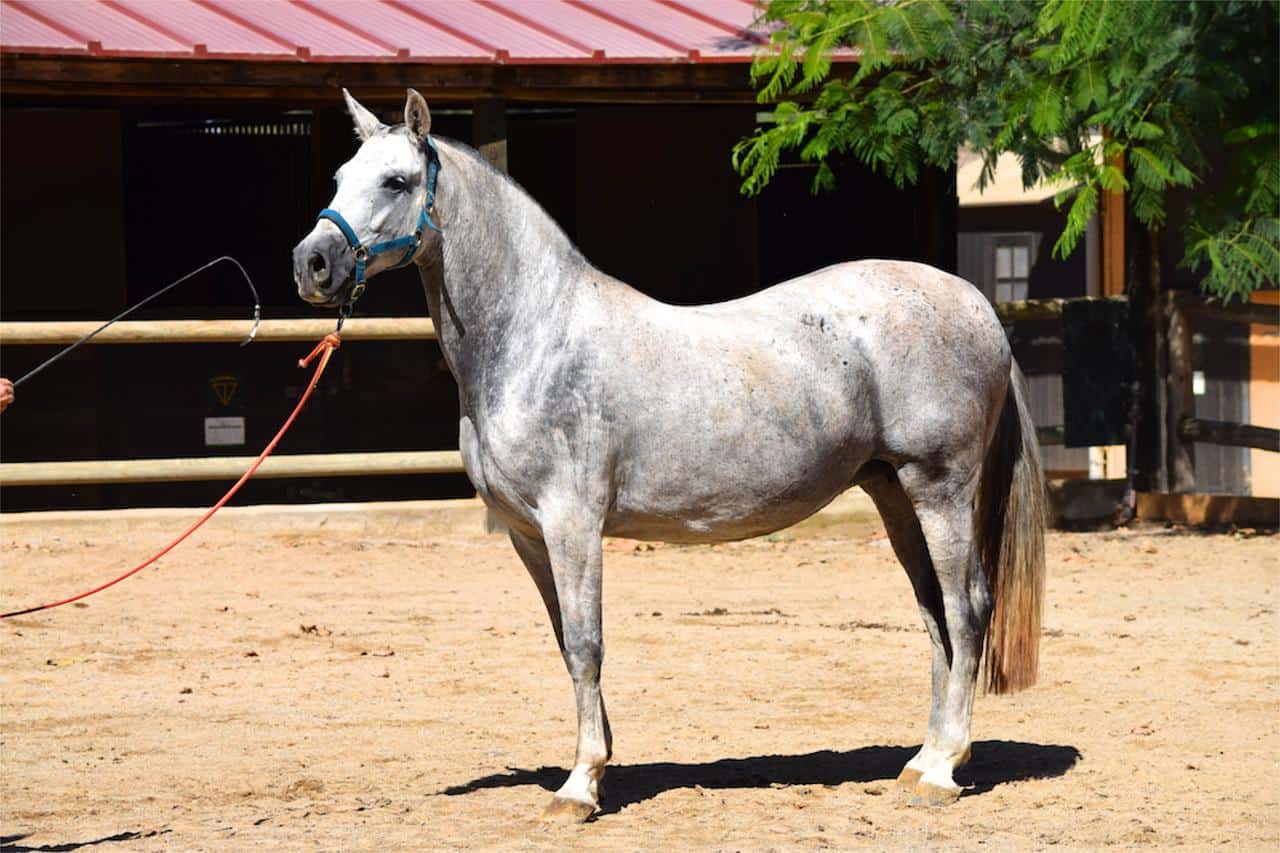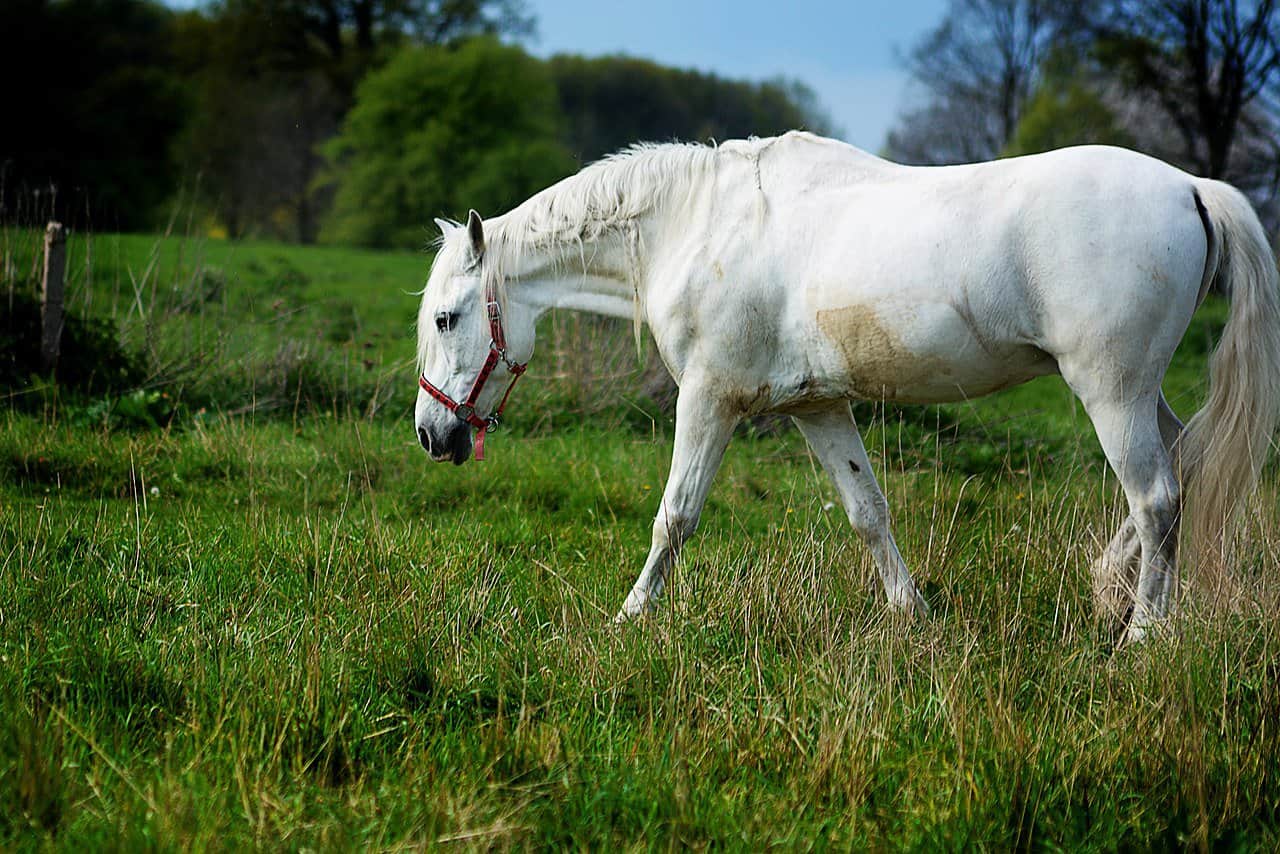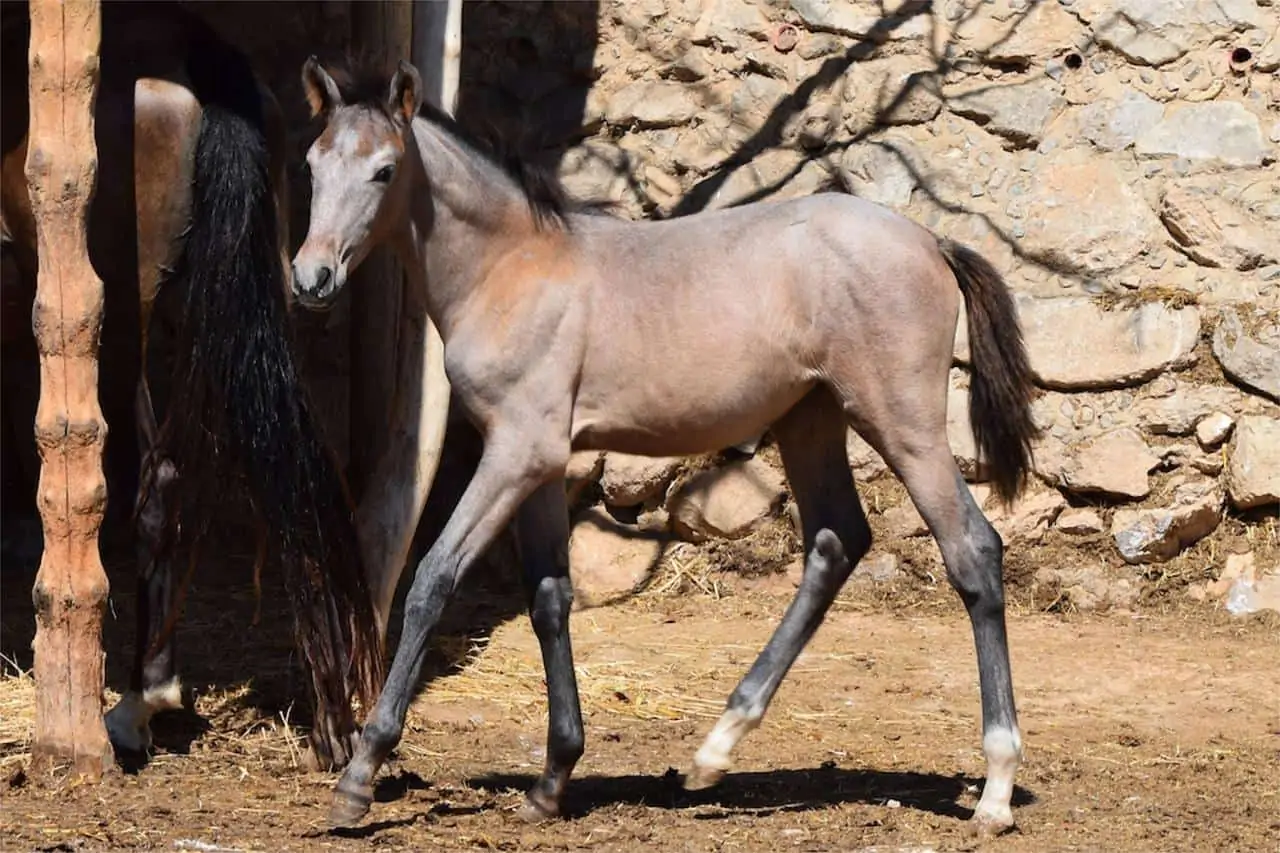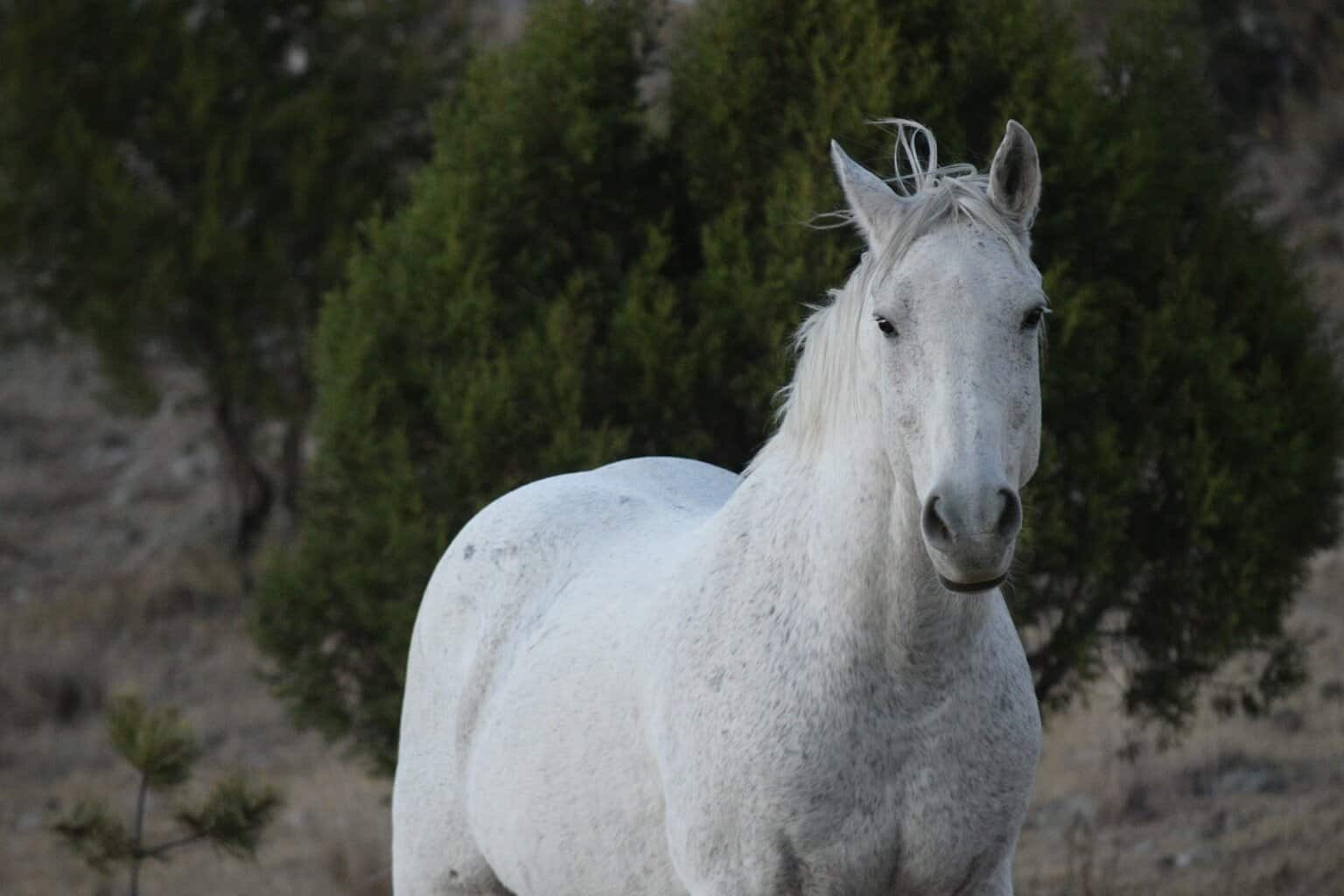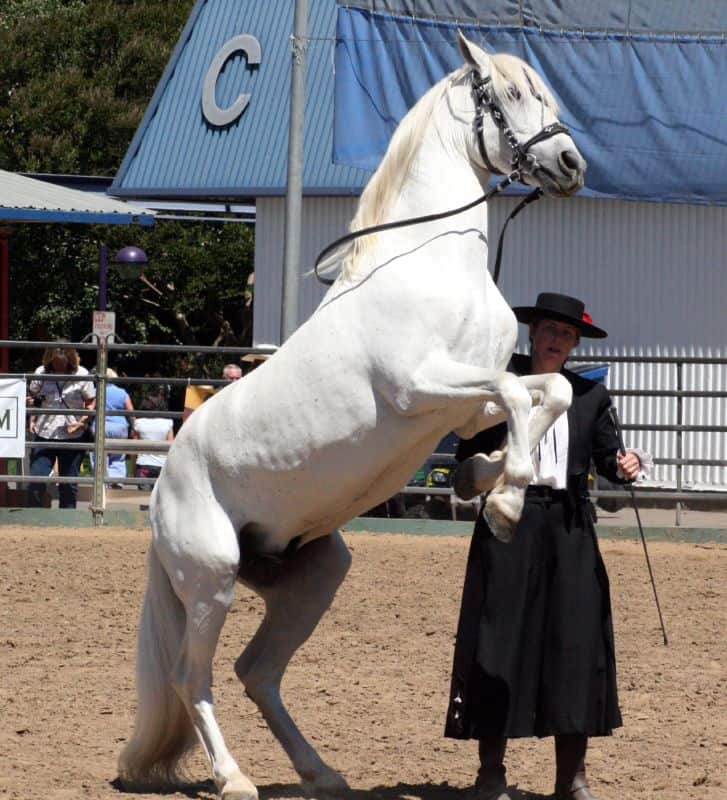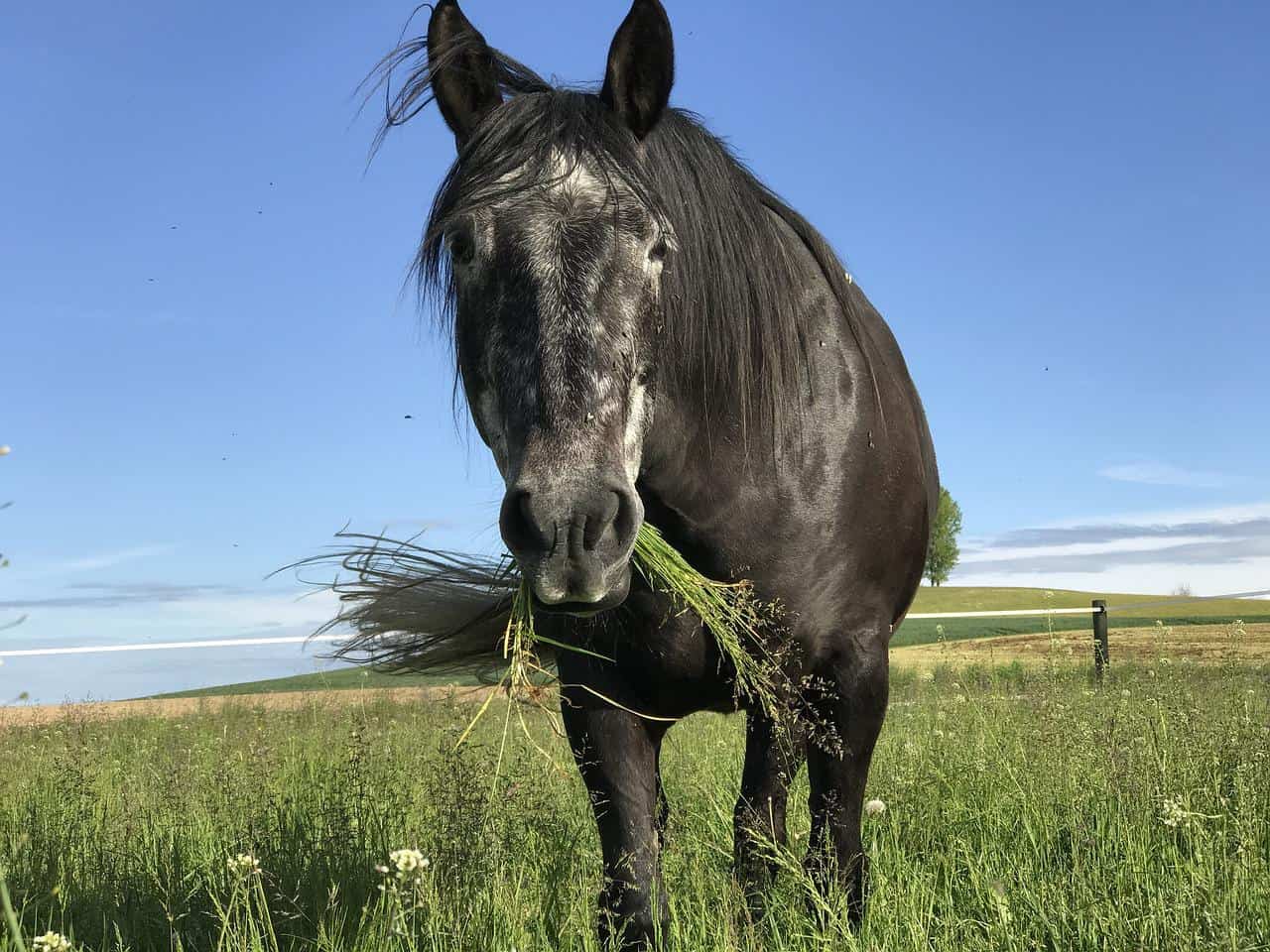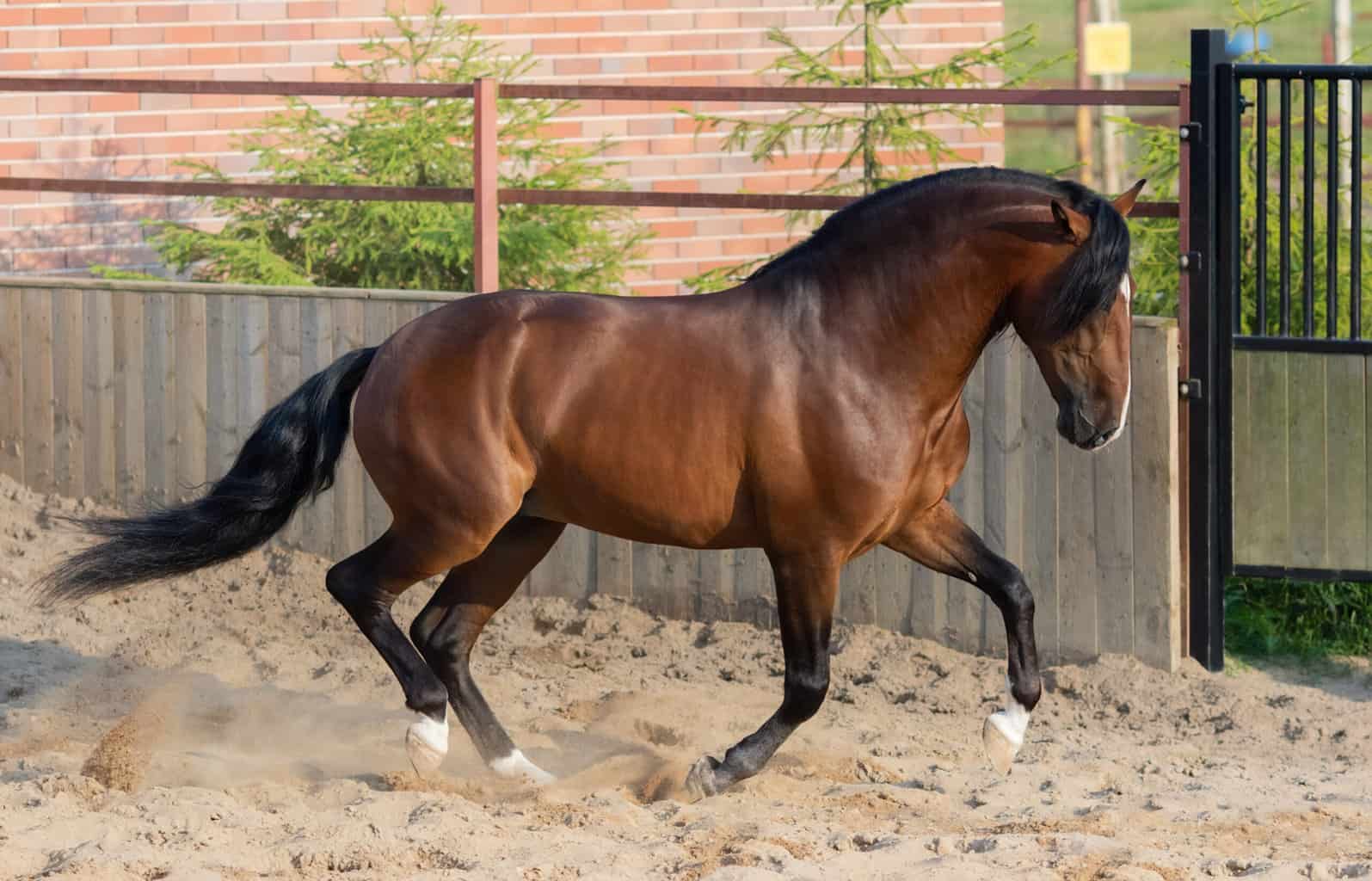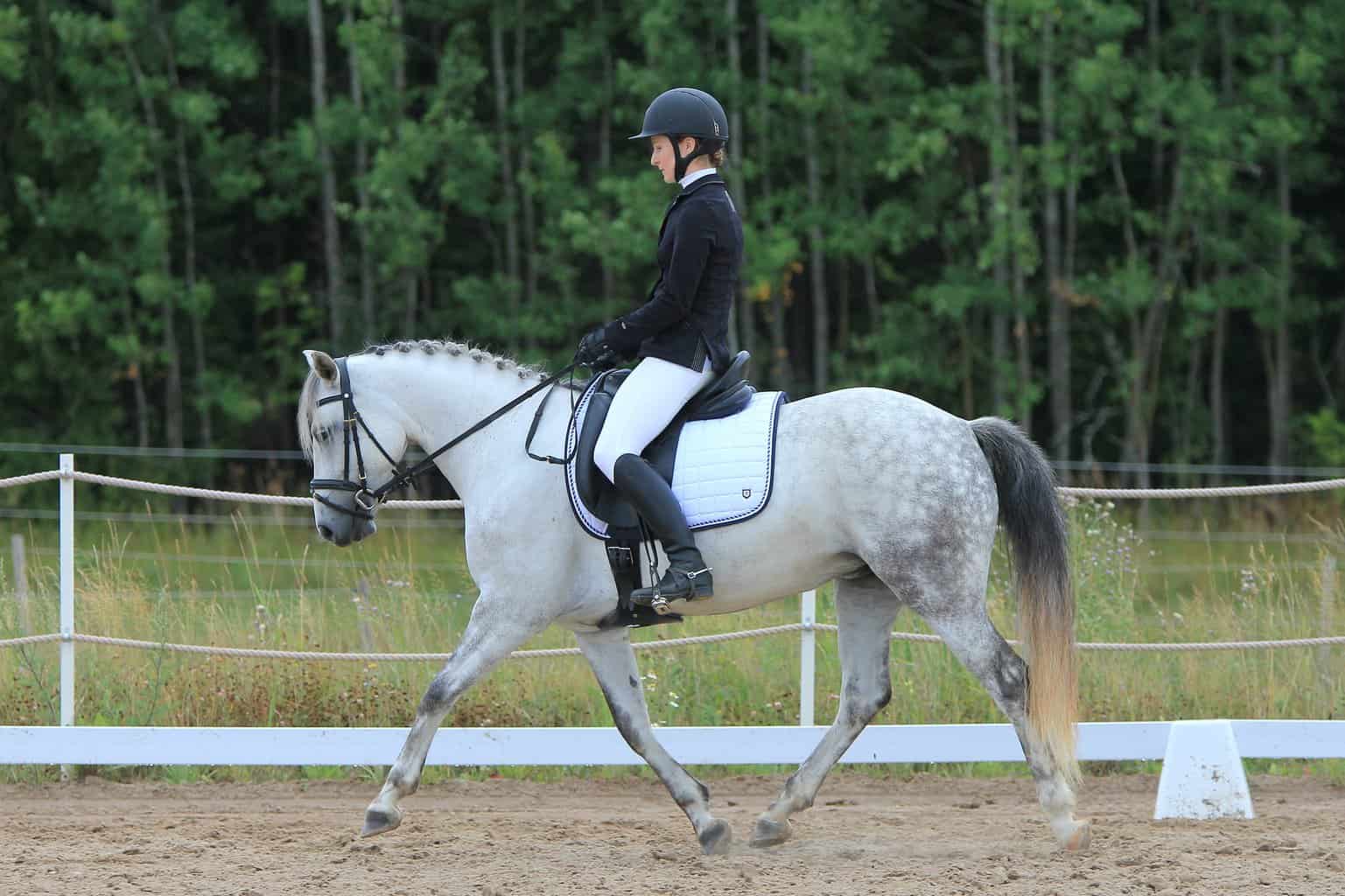- Best Horse Show Halters Guide - July 13, 2022
- Best Bareback Pads Guide - July 5, 2022
- Best Western Bitless Bridle Guide - July 3, 2022
- Andalusian Horse Overview
- How to Identify an Andalusian
- Andalusian Life Span
- Andalusian Appearance and Varieties
- Andalusian Human Interaction and Training
- How to Care for an Andalusian
- Andalusian Diet
- Andalusian Horse Breeding
- Andalusian Horse Cost
- Where to Buy an Andalusian Horse
- Andalusian Horse: FAQs
- Famous Andalusian Horses
If you’re looking for a horse that will make every other rider’s jaw drop when entering the ring, look no further than the Andalusian.
Advanced equestrians perfected this ancient Spanish breed before many breeds even existed. Andalusians remind us that the horse was once a weapon with equal stamina, strength, intelligence, and size. Don’t let their flowing locks fool you; these horses were once war machines and are capable of almost any task you put them to.
Their grace is a tribute to their strength. When I first saw an Andalusian move, I thought that it how odd that something so muscular and stocky could move so well. In addition, Andalusians are highly trainable and valued for their even temperaments.
An Andalusian is not some hot-headed monster, as its build might suggest, but instead a well-rounded, intelligent animal. The intricate and complex movements that these horses can learn set them apart from younger or hotter breeds.
Andalusian Horse Overview
Andalusians are wonderful at almost any task you put them to. They are powerful horses of a medium-large build. They are famous for their exhibit in Cordoba, Spain, where the animals leap, kick and perform impressive ground maneuvers year-round. These Andalusian stallions stretch the limit of what is possible between a horse and a human, performing ancient war techniques and beautiful dressage movements.
Andalusians are descended from Spanish warhorses valued for their intelligence and robust build. The Andalusian retains these qualities and excels in the dressage ring. They also make world-class jumpers, with their height and power giving them an upper hand over the fences.
Andalusians are most often bay or grey horses. A black, cremello, or buckskin Andalusian may be registered, though they are rarer than a bay or grey Andalusian. Flashy colors are not a priority for Andalusian breeders. They are more concerned with their horses’ confirmation, personality, power, and intelligence.
Andalusian Quick Facts
- Horse Breed: Andalusian
- Common Names: Andalusian, Spanish Horse, Iberian Horse
- Country of Origin: Spain
- Height: 15.1 hands
- Weight: 1100 lbs
- Color: Usually Bay or Grey
- Coat Quality: Short and Very Healthy
- Body Hair: Lush mane and tail that are kept long.
- Temperament: Fiery but very trainable, docile on the ground
- Lifespan: 20-30 years
- Purpose: Excels at dressage but can be used in many other disciplines
How to Identify an Andalusian
Andalusians are stocky and powerful while remaining athletic and agile. To be registered, mares must be at least 14.3 hands, and geldings and stallions must be 15 hands. Many Andalusians are larger, crossing well into 15 hands. Andalusians are usually bay or grey but may be registered in other colors such as buckskin, cremello and black. Their manes and tails are kept long and wavy. These healthy locks are a telltale sign of the breed.
You will best be able to pick out an Andalusian by its steady and forward movement. Their large muscles and joints allow them to move very gracefully, and many pick this up without training. Andalusians are bred for their intelligence and agreeability, so they are very collected and forward movers with a little training.
The Andalusian greatly resembles the Lipizzaner and Lusitano, depending on their color. All three breeds are descended from the same ancestor, and it would take a highly experienced equestrian to tell them apart. They now hail from different areas of Europe. The Andalusian remains in Spain, while you’ll find Lusitanos in Portugal and Lipizzaners in what used to be Austria but is now Slovenia.
Andalusian Life Span
Andalusians have an average horse life span of 25 years. They are often well taken care of horses which considerably lengthens their expected life span. Andalusians are also a more expensive breed, which means their owners usually have the means to provide adequate vet care.
Andalusians are one of the purest breeds of horses and come with their own set of genetic issues. For whatever reason, they often have small intestine issues and metabolic issues. Cushing’s disease and laminitis are more common in Andalusian horses.
Andalusian Appearance and Varieties
Andalusians are very athletic and forward-moving horses. They are blessed with eye-catching movement and a robust build. You may not recognize an Andalusian from just a photo, but you will likely recognize them under-saddle or in the pasture.
The Andalusian breed is one of the purest breeds in the world. There are no registered varieties, and there are only 200,000 registered Andalusians. They are a somewhat rare but particular breed. Most of them are grey or bay, but you may find Andalusians in buckskin, cremello, chestnut, and any classic horse color. Their looks are so elegant and grand that they are often the stars in fantasy movies, jousting at Medieval Times, or prancing through parades.
Andalusian Human Interaction and Training
You may think that because of how beautiful an Andalusian horse is that it may be challenging to train one. This couldn’t be further from the truth. Iberian horses, such as the Andalusian, are descended from the versatile and well-tested Spanish warhorse.
They are some of the most trainable, agreeable, level-headed, and intelligent horses around. There was no room for a hot-head in the middle of battle, but a huge spirit and bravery were a must.
The horses are meant to be highly malleable and intelligent, with a massive change in demeanor when they walk into a show ring. Andalusian trainers claim there is a moment right before their horse is asked to work hard that it will go from a docile and laid-back creature to an animal explosion, with a massive burst of energy that may be hard to deal with as a new rider. This quick change in demeanor is bred into their very nature.
I met rows and rows of Andalusian stallions before an exhibit in Spain with this classic Iberian demeanor. Before the show, the stallions acted like puppies, allowing guests to cuddle and brush them while lazily eating hay or even laying down and snoring. I couldn’t imagine what they could do in the ring with such easy-going temperaments.
The first stallion out of the gate lept high into the air, kicking out his back feet in an incredible display of athleticism. It was unbelievable that he had just had complete strangers scratching his nose in the stables only moments before.
You can imagine what a benefit this nature was to soldiers in and out of battle. This ability to amp up when needed and be overly pleasant when not is critical for a cavalry horse. An aggressive mess would get them killed off the field. For this reason, their personalities are still the most bred-for and essential feature of the breed today.
How to Care for an Andalusian
Andalusian horses are considered very durable, but they do have some consideration for their care. The most important thing you can do for your Andalusian keeps it at the appropriate weight through diet or exercise. The breed is prone to metabolic issues and will develop problems if allowed to remain overweight. It may be hard to withhold grain from such a charismatic and charming animal, but their small intestines will thank you later.
Due to their intelligence, exercise and training are already highly recommended for the breed anyway. You don’t want a bored Andalusian on your hands or one that has not bonded to you due to neglect. Consider a less interactive breed if you’d like a horse happy to roll around the pasture. This breed enjoys working with humans, solving problems, and learning new movements. An Andalusian should be put to work, or they’ll find their projects to get into.
Grooming an Andalusian is almost a full-time job, especially if you decide on a grey horse. Their coats can be curried and bathed like any other breed, though getting dirt out of an essentially white horse is a challenge.
If that’s not enough, their manes and tails grow very long (and are a trademark of the breed) and require special consideration. The long locks of an Andalusian must be conditioned and combed regularly. It’s wise to consider braiding or tieing up their hair when not in the ring, or you may just be creating more work for yourself.
The Andalusian is a spirited horse, especially when performing or working. You may need to be a skilled rider to fully appreciate owning an Andalusian or be committed to becoming one.
Andalusian Diet
Feed an Andalusian a fiber-rich, calorie-appropriate diet. Your most important task is to keep them at a healthy weight. A working Andalusian may need plenty of calories to support their stocky, muscular build. As they age, or if they are on break due to injury, etc., be careful not to overfeed them.
The breed’s small intestine has difficulty functioning already, and the horses are prone to metabolic issues. Being overweight will significantly increase their likelihood of developing Cushing’s and other related problems.
Andalusian Horse Breeding
Andalusians are predominantly bred for their personalities and their athleticism. Their epic good looks come second but are a distinguishing and important feature on their own. They are known for their intelligence and agreeability. An experienced equestrian can turn an Andalusian into an incredible horse in any discipline.
Though Andalusians were initially bred for bullfighting and war, they are now used for dressage, jumping, and even pulling. They are spirited by nature, bred to be lively companions, and may not be suited for any but the most motivated beginner horse owners.
Andalusians, along with their close Iberian relatives, the Lusitano and the Lipizzaner, are bred specifically to perform ancient war movements on display in their home countries. These movements, which now resemble or could be considered dressage, are complex and require the highest degree of trainability and athleticism. Their breeding programs are among the strictest in the world. The Spanish see Andalusians as part of their national pride, not just a horse breed.
The Andalusian we know today was explicitly bred for bullfighting in the Andalusia province of Spain. They are still used in the sport to this day, though their armor and protective measures have improved considerably. The bravery required to obey commands in close proximity to an angry bull is a flagship quality of the breed.
There are few horses with the athleticism and gumption to participate in this sport, and there are none like the Andalusian. Their level-headedness is in sharp contrast with their tremendous spirits and powerful movements.
Andalusian Horse Cost
While not the least expensive option, Andalusians can be surprisingly affordable for a world-class horse breed. Large warmblood purebreds are a known expense in the dressage, and jumping world and Andalusians won’t be an exception. You can expect to pay $20,000+ for a young Andalusian and $50,000+ for a well-trained and proven Andalusian.
These prices will largely depend on where you live and the transport cost. Andalusian breeders are rare in the Americas, and you may be looking at getting your new horse across the Atlantic.
If you are persistent and resourceful, you can get an Andalusian school drop-out, but you’ll need to transport it from Europe. These are top-of-the-line horses who may be rejected from the exhibit and breeding program for minimal issues such as size or color. They will still be relatively expensive but are a deal when you consider the breeding program they come out of. Their lines can be traced further than any horse alive, over generations of proven stallions and mares.
Where to Buy an Andalusian Horse
Be very careful buying “Andalusian” horses over online marketplaces. Online horse auctions have revolutionized the market, but they can cause more harm than good for a breed like this one.
An Andalusian is bred simultaneously for its gentle and malleable personality, powerful movements, and spirited nature. A well-established breeder will remove personality variations from their breeding stock because they value the breed’s integrity over fancy colors or making a couple of extra bucks.
An Andalusian bred without these considerations can be dangerous and riddled with health issues. These powerful horses can do a lot of damage. They have thousands of years of bravery bred into them and are intended to have a docile, human-loving nature to balance that out. In addition, the horses online that claim Andalusian bloodlines are wildly expensive for what you’ll end up with.
They may be less expensive than an Andalusian from a good breeder, but they are much more expensive than other, more valuable horses.
It is best to seek a proven and respected breeder when shopping for an Andalusian. This should be a red flag if a breeder doesn’t show their horses. Andalusians are meant to work and love performing. They should be exercised regularly for their health, and their abilities should be tested regularly to warrant remaining in the breeding program. A great breeder is excited to watch their horses excel in whatever discipline they love the most.
Andalusian Horse: FAQs
Answer: An Andalusian is well suited for any discipline that requires athleticism and a high level of training. They specifically excel at dressage and have been trained in this manner for thousands of years. Andalusian horses do not do well with a more sedentary lifestyle. They enjoy learning and performing, and it’s much healthier for them to be busy.
Answer: Andalusians may very well be the best horse. Their breed has been perfected longer than almost any other. Andalusians are indeed a very versatile breed, excelling in many different disciplines. Their level-headedness and natural athleticism, bravery, and spirit make them stand out as ideal partners.
Answer: The Andalusian can be fantastic for any dedicated rider. If your beginner wants a responsive and intelligent animal and is willing to put the work into growing with their horse, then an Andalusian will be an incredible partner. However, the Andalusian will get bored quickly and test a novice rider. They are not an easy horse for a beginner, but a highly rewarding horse for the right beginner.
Answer: A young and unproven Andalusian will run $20,000+ while a highly bred or trained Andalusian should run $50,000+. This is expensive for a horse but in range for a European warmblood. Buy your Andalusian from a trusted stable. Do not search for a deal online or locally; this isn’t an excellent breed to cut corners with.
Answer: Trainability is one of the most bred qualities in an Andalusian. Not only that, but they have the unique Iberian ability to accept commands under pressure. Whether bullfighting or charging into battle, the most critical aspects of the Spanish horse were to learn movement and execute commands.
Famous Andalusian Horses
You may not have noticed it, but Andalusians permeate Hollywood culture. They are often used in shows and movies due to their high trainability and epic looks. Grey Andalusians portray the famous Shadowfax throughout the LOTR series. Arwen also rides Andalusians throughout the films, including the iconic scene where the ringwraiths are right on her tail.
It makes sense that fantasy shows and movies love Andalusians, but did you know Clint Eastwood rode Andalusians in many of his “spaghetti” westerns. Their long locks and large form under a western saddle ignited America’s imaginations. You may think that this is just a little bit of Hollywood glow-up, but Andalusians were used by Spanish and European colonizers in the Americas, including the west.
The most famous real-life Andalusian was a warhorse belonging to El Cid Campeador. Babieca was his master’s warhorse for 30 years, and they were always victorious. Babieca even carried El Cid into battle after the man had passed. El Cid was mortally wounded in battle and died back at camp without the enemy knowing his condition.
For the following battle, El Cid’s troops dressed his body in full armor and tied him to Babieca. Babieca charged into battle one final time, all on his own, to instill fear in the enemy. He won this last battle as well.


